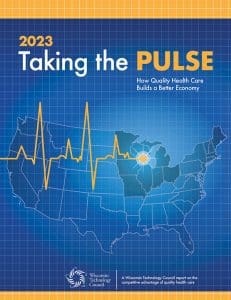 Wisconsin’s consistently strong rankings for quality health care are a tangible marketing asset in the competition to attract and retain workers and businesses from other states, regions and nations.
Wisconsin’s consistently strong rankings for quality health care are a tangible marketing asset in the competition to attract and retain workers and businesses from other states, regions and nations.
Top-quartile rankings for health-care quality and cost figures roughly in line with regional and national figures mean Wisconsin workers and companies hold a competitive edge – but workforce shortages that began even before COVID-19 and the need to stay abreast of technology make continued progress a challenge.
Those are among conclusions in “Taking the Pulse: How Quality Health Care Builds a Better Economy,” a report issued Wednesday by the independent and non-partisan Wisconsin Technology Council. Drawing on a combination of public and private data, key findings in the 20-page report are:
- Wisconsin is consistently one of the top states for quality health care, as measured by metrics compiled by the federal Agency for Healthcare Research and Quality. In its 2022 “National Healthcare Quality and Disparities Report,” the AHRQ ranked Wisconsin and 11 other states in the nation’s top quartile through 2021. In the region surrounding or within a day’s drive of Wisconsin, only three other states (Iowa, Minnesota and North Dakota) ranked in the top quartile.
- With some key indicators – such as mortality amenable to health care, Medicare 30-day readmissions, penalized hospitals and average hospital length of stay – Wisconsin performance was well above average.
- Mean inpatient charges in Wisconsin were in the middle of the seven-state region in the latest year on record and leveling off, according to AHRQ. In contrast, the U.S. average was much higher and trending up.
- That cost-related finding was reinforced in a 2022 report by Forbes Advisor, which analyzed data from the Kaiser Family Foundation comparing all 50 states and the District of Columbia on average health care costs per person. The U.S. average was more than $10,000; Wisconsin was the 8th least expensive state with a per capita rate of $9,626. That same Forbes study found that Wisconsin’s health care cost increases over the past five years were sixth-lowest in the nation.
- Most single and family health insurance premiums in Wisconsin were competitive with regional and U.S. averages in 2021. The exception was average premiums for family coverage paid by employers. That figure was $15,676, or second-highest in the region and higher than the U.S. average of $15,207.
The report noted continued improvement in key metrics related to Wisconsin’s Worker Compensation costs and effectiveness. The average cost of WC insurance per $100 of payroll in Wisconsin was $1.32 in 2020, compared with $1.72 in 2016, according to the National Academy of Social Insurance. The state Department of Workforce Development has charted recent figures that show most employers are paying less than in previous years for WC insurance, and workers are getting back to work faster.
In addition to data charting quality and cost comparisons, the report contains other findings and recommendations:
- Public and private entities should promote measurable, quality health care at generally affordable prices as a magnet for workers and companies. In an era when health care can attract people and expanding companies, state agencies and private associations with the ability to promote Wisconsin’s health care quality should do so.
- Rural health care and hospitals must retain their resiliency. Wisconsin hasn’t seen a hospital close since 2011. Like broadband and housing, quality and available health delivery systems are essential to sustaining the rural economy. While Wisconsin ranks low on one “immediate risk of closure” list for rural hospitals, those hospitals face daily challenges.
- Encourage teaching institutions to efficiently produce health care workers. Wisconsin has what some people describe as a surplus of higher-education schools. Those schools can better demonstrate their value by continuing to train potential health industry workers. This includes public and private colleges.
- Keep working to increase the availability of mental-health treatment, especially in an era when opioids, fentanyl and other abused substances are killing far too many people.
- Establish more partnerships between Wisconsin health research resources and providers. Health information software is just as important to maintaining quality and controlling costs as are improved diagnostics, imaging and therapeutics. Wisconsin has resources in each of those sectors, something few states can claim.
The report features other data and trends from national organizations. It is available online at www.wisconsintechnologycouncil.com. Printed copies are available by emailing julie@wisconsintechnologycouncil.com.




